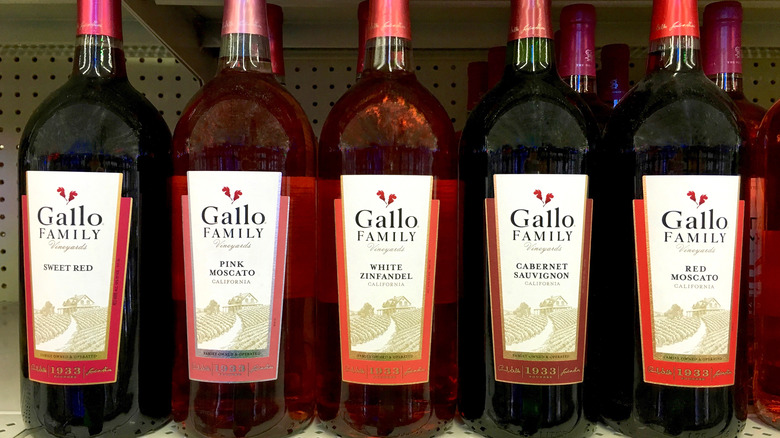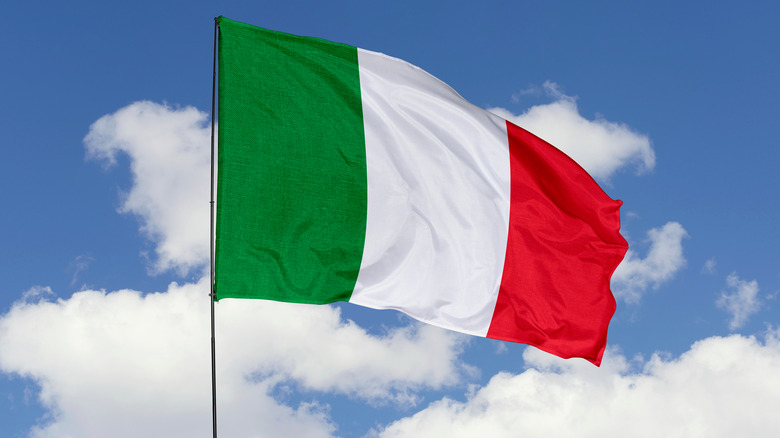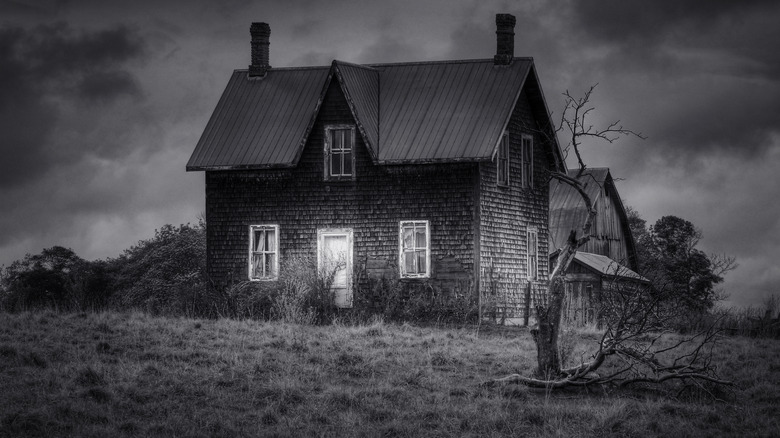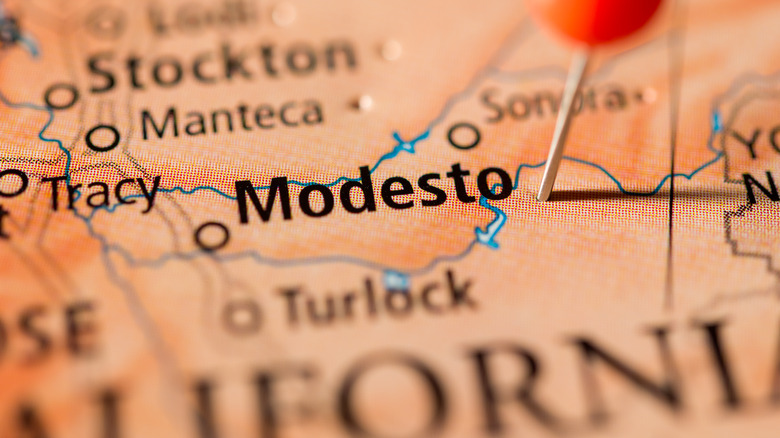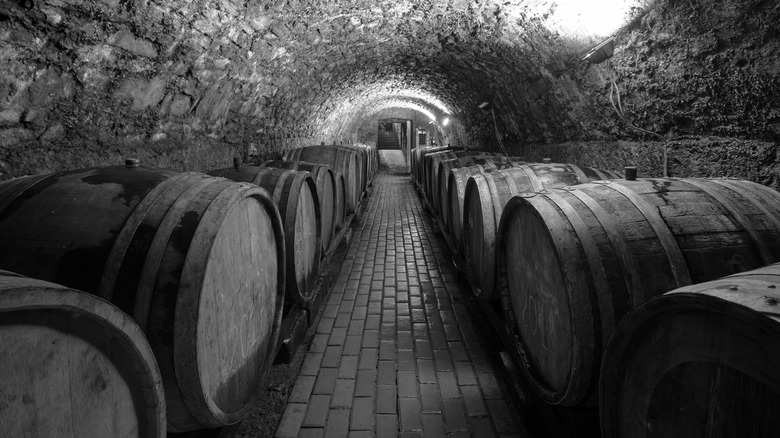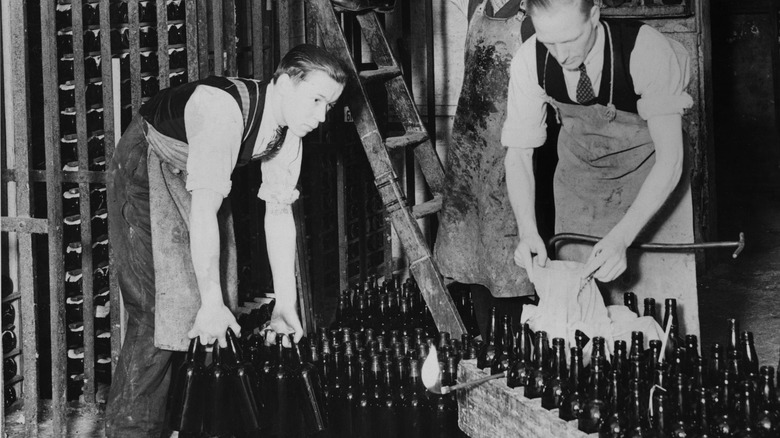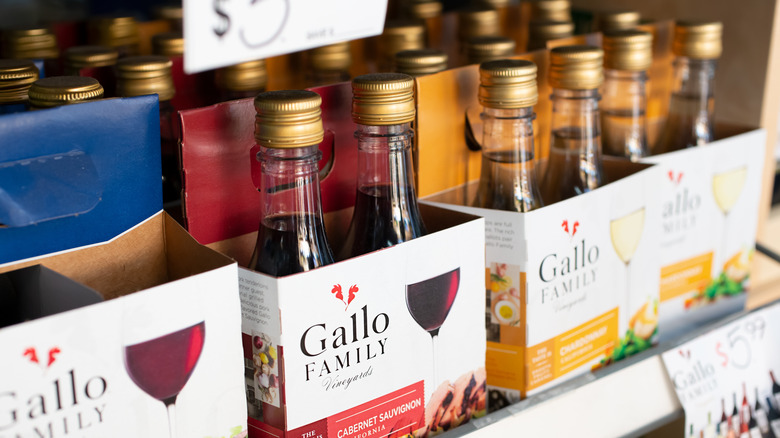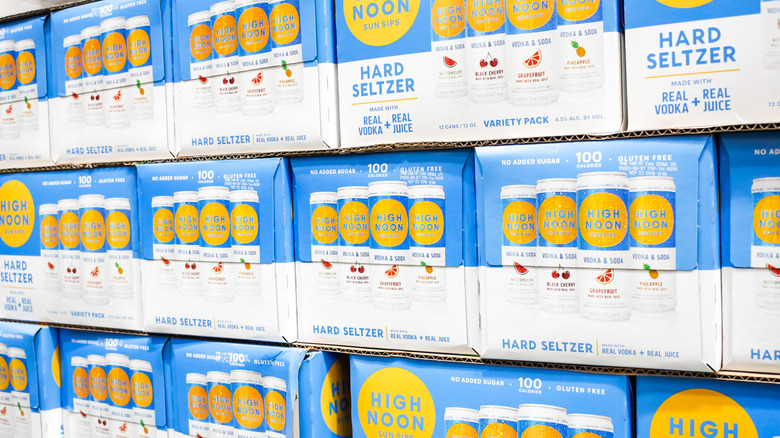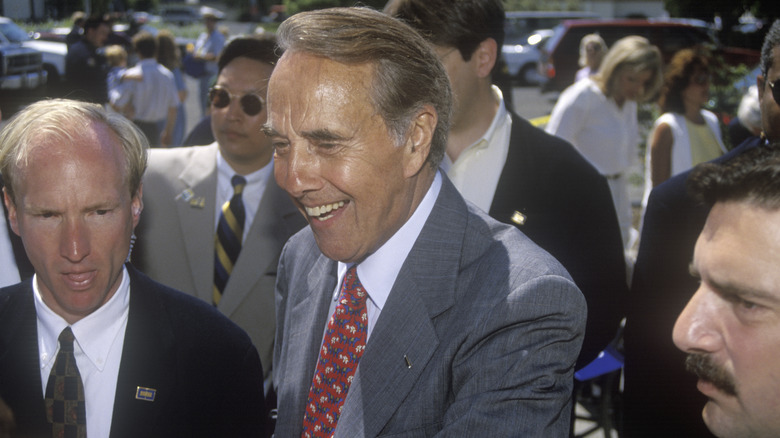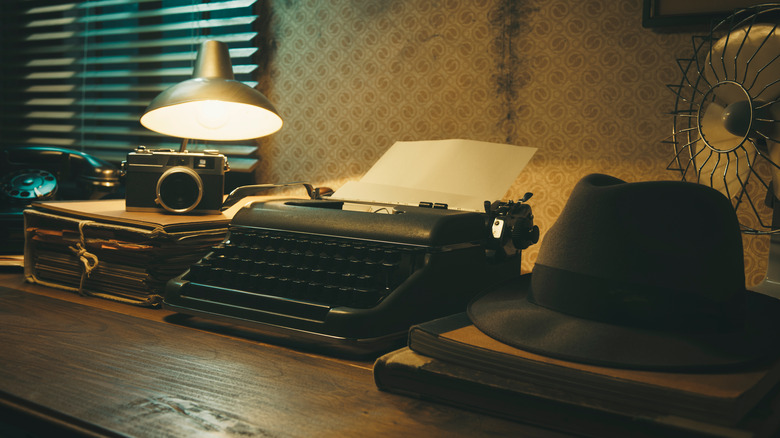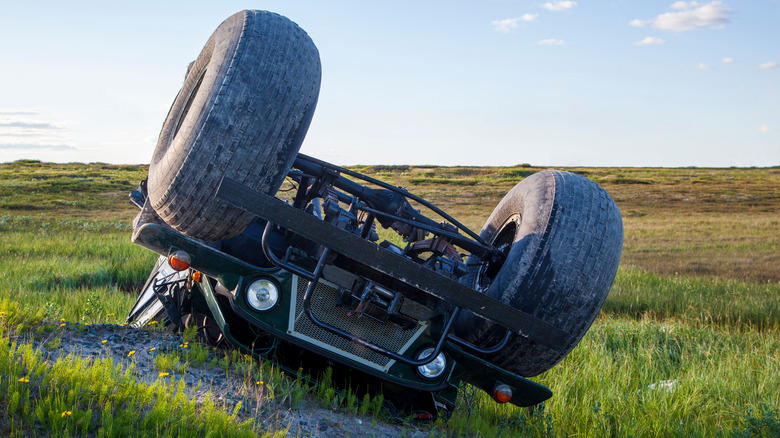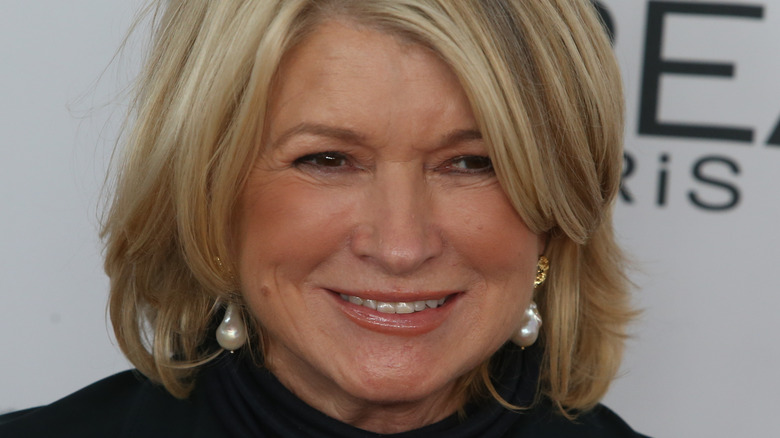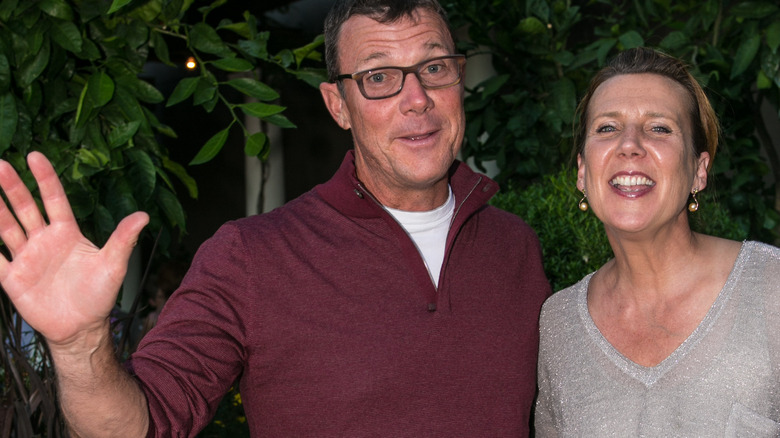The Complete History Of E. & J. Gallo Winery
We may receive a commission on purchases made from links.
The history behind the family-owned E. & J. Gallo Winery can be likened to the depth and complexity of some of its many products. There was a tell-all book exposing family secrets, a court scandal over cheese, and a real-life family tragedy involving a murder-suicide. The company's battles with the United Farm Workers was on and off for years until a new contract was finally signed.
But there has also been a long-running faith and commitment to preserving a family legacy that spans nearly a century. Known for being one of the top-rated wine dynasties in California's storied history, E. & J. Gallo Winery is also the world's top wine producer (via Good Pair Days). The corporation founded by brothers Ernest and Julio offers an array of products through more than 130 different brands, including Barefoot Wine, High Noon hard seltzer, E&J Brandy, and Carlo Rossi wines. It also had a partnership with the likes of Martha Stewart and has been known for contributing to political campaigns, including to former U.S. Senator Bob Dole and former President Bill Clinton (via SFGate).
The Gallo name also has an impressive number of trophies and awards from prestigious competitions around the world, as reported by E. & J. Gallo Winery. And the company is widely recognized for its environmental sustainability efforts and practices as well as its commitment to human rights.
Keep reading for the complete history of this fascinating Italian-American wine dynasty.
The Gallo family emigrated from Piedmont, Italy
Before the Gallos became the powerful American wine dynasty we know them to be today, the family traces its roots to the province of Piedmont, Italy. According to a University of California, Berkeley manuscript of a 1969 interview with company co-founder Ernest Gallo, his paternal grandfather made a living there as a horse trader and butcher.
Ernest and Julio's father, Joseph Gallo, was about 19 years old when he left Italy for South America and after about a year moved to the United States. He landed in Philadelphia and began working in the coal mines. The work was dangerous and difficult, so Joseph saved up enough money to travel to California for a better life, according to the interview with his son.
After living in San Francisco and working as a ditch digger for about a year, Joseph met the Biancos, another Italian immigrant family with ties to Bologna, Italy, as well as the region of Piedmont. Ernest Gallo said in the interview that his maternal grandfather, Batista Bianco, was a small grape grower in California's Central Valley. Joseph began buying barrels of wine from Batista to sell to Italian boarding houses in San Francisco. Soon thereafter, Joseph wed Batista's daughter, Assunta Bianco, and the couple gave birth to two sons, Ernest in 1909 and Julio in 1910, according to the 1969 interview. Their youngest brother, Joseph, was born about a decade later in 1919 (via Joseph Farms).
The Gallos experienced a murder-suicide tragedy in 1933
On June 21, 1933, The Fresno Bee reported that the bodies of Joseph and Assunta (who went by Susie) Gallo were found dead at their ranch, and they were believed to be the victims of a murder-suicide. The Guardian notes that some believed their deaths to be a result of mob activity as Joseph's brother was a well-known mobster, but investigating officers determined that Joseph shot his wife in the back of the head while she was feeding hogs on their family ranch, where they had lived for several years, according to The Fresno Bee. Using the same caliber revolver as the one that killed Susie, Joseph allegedly proceeded inside the house, where he stood in front of a mirror and fatally shot himself in the head.
Susie's body was discovered by ranch workers, and Joseph's body was subsequently found by officers who responded to the scene, according to the newspaper report. Ranch workers claimed there was no known trouble between the couple, and the investigation did not lead to any signs of foul play. The couple was survived by their three sons: Ernest, Julio, and Joseph, who was just 13 at the time.
Two eldest brothers founded E. & J. Gallo Winery in Modesto, California
After the tragic death of their parents and with the repeal of Prohibition on the horizon, brothers Ernest and Julio Gallo decided to officially launch their own brand of wine. The brothers had been in business with their father, Joseph, selling grapes to Italian families in the Midwest and the East Coast during Prohibition. They founded E. & J. Gallo Winery in Modesto, California, on Aug. 21, 1933, according to the Ernest Gallo interview with the University of California, Berkeley.
Their goal, according to The Guardian, was not to simply distribute grapes as their father had done thanks to a loophole in the 18th Amendment, but also to make and sell wine. Per Wine Spectator, the young men didn't have much knowledge about winemaking, so they checked out some pamphlets from their local library, took out a small loan to rent a warehouse, and ambitiously set out to launch their namesake wines. Bringing their unique personality traits and strengths to the table, Julio took on the production side of things while Ernest became the head of sales and distribution.
The Gallo brothers sold their wine despite being told not to
As soon as Prohibition was repealed in December 1933, the Gallos were ready to sell and ship their product. Some senior winemakers advising them that their wine was too young to distribute. But the brothers were determined to turn a profit on their new venture rather than wait a year for the wine to age. Ernest and Julio argued that their wine was drinkable and would sell regardless of aging, so they distributed it at a starting price of 50 cents per gallon, as retold in a University of California, Berkeley transcript of an interview with Ernest Gallo in 1969.
E. & J. Gallo Winery competed with other big names from California like the Franzia family, who were also in the bulk red-wine business, but the brothers' turn-and-burn style of making and selling wines quickly made a splash across the U.S., and their profit margin grew along with their family's name and reputation.
Gallo sold its wines in barrels until 1939
E. & J. Gallo Winery started distributing its wine shortly after Prohibition ended in 1933, and it did so by shipping it in bulk barrels across America, as detailed by Ernest Gallo himself in an interview documented by the University of California, Berkeley.
The business exploded, and the Gallos were looking to expand their product to include table wines available by the bottle.
In 1939, Ernest traveled to New Orleans to meet with a company that had been purchasing Gallo barrels and bottling the wine for resale. Ernest was interested in buying shares of the company so he, too, could profit off of the sale of his wines through bottling. In exchange for the shares, Ernest would cancel that company's debt of about $30,000 -– a considerable amount at that time. The bottling company owner quickly agreed. Shortly thereafter, the owner of the bottling company was arrested and charged with white slave trafficking, so Ernest said in the interview that he swooped in and bought the owner's shares, ultimately transitioning Gallo wines from barrel to bottle.
Gallo is the world's largest family-owned winery in the world
E. & J. Gallo Winery owns 19 wineries in California, Washington, and New York, and in January 2021 it acquired another 30-plus brands of wine, according to Gallo.com. From bottom-shelf brands like Barefoot Wine and Boone's Farm to middle-grade brands like Ravenswood and Wild Horse and higher-end labels like J Vineyards and Orin Swift, the Gallo family represents a slew of wines found on grocery-store shelves across the United States.
Even more impressive are the vineyards, which sprawl over 23,000 acres in California and Washington, and rake in a booming $4.1 billion in revenue annually, according to one estimate from Visit California. That doesn't include over 100 brands of beverages, distilled spirits, and various wines the company represents (per E. & J. Gallo Winery).
What truly sets the company apart is its family values. E. & J. Gallo Winery is on its fourth generation of family involvement, with three generations currently working at the winery's headquarters — 15 family members total. There's also a striking 7,000-some employees working for the company's many branches and brands around the world.
United Farm Workers have boycotted Gallo over the years
After a series of boycotts by the United Farm Workers, Gallo claimed in 2008 to be the largest unionized winery in the country, according to Family Business Magazine. But the story wasn't so boisterous in the 1970s, '90s and early 2000s for the Gallo company and its unionized workers.
In 1973, a strike and boycott broke out between the union and Gallo wines, which led millions of Americans to boycott Gallo wines in 1975. In the late '90s and early 2000s, Gallo wines and UFW members were at it again over labor contracts, which led to further boycotts. Disputes in the early to mid-2000s included unfair labor practices and disagreements over health benefits.
The company and the union have since worked out their differences, with Gallo now listed among the labels that UFW contracts with where members "enjoy good wages, benefits and working conditions" (via UFW).
The Gallo brand expanded in 1975 to include liquor
The Gallo empire includes more than 130 brands that range from booze to canned seltzers to luxury wines, with its first acquisition dating back to 1975 when the company introduced E&J Brandy, according to a company news release. With its March 2022 launch of Spirit of Gallo brand, E. & J. Gallo Winery boasts that its volume as a spirits supplier makes the company the fourth largest in the country.
According to an E. & J. Gallo Winery fact sheet, Gallo brands consist of a massive network of distribution branches around the globe, importing and exporting wine and spirits in and out of over 100 countries, including Australia, Argentina, France, Germany, Chile, New Zealand, Spain, South Africa, and the U.S. Its headquarters is in Modesto, California.
Though brandy was the gateway into the world of distilled spirits, Gallo's portfolio now includes Scotch whisky, vodka, gin, rum, tequila, and vermouth. Adding to that are other brands the company offers, like popular hard seltzer High Noon, which representatives say was created as an alternative to beer at social occasions that call for a canned beverage.
Gallos were known for their political involvement
No wine dynasty spread over nearly a century would be complete without an ongoing entanglement in politics, with large contributions meant to sway beneficial outcomes like lower taxes and government subsidies. In fact, SFGate reported in June 1996 that the Gallo family was the largest contributor over the years to Bob Dole, who served five terms in the U.S. Senate before he turned his focus full time that year to running for president. The Gallo family was also a huge donor for two-term President Bill Clinton.
Both the founding brothers, Ernest and Julio, began the tradition of making large financial donations to presidential campaigns, and it has been carried on in their honor since. According to PBS, the Gallo corporation has always been bipartisan in its support of politicians over the years, and its family members have doled out millions. Their support for a candidate has historically been based on benefits to the wine and spirits industry, which in turn benefits the Gallo company.
And while the family's political contributions over the years are public record, Ernest Gallo was not willing to publicly comment on such matters, preferring to keep its political points of view on the hush-hush, according to PBS. That being said, the family's contributions are directly linked to those with sway over certain tax laws as well as other measures that benefited their business.
The Gallo family went through a messy lawsuit in the 1980s
Over the years, the Gallo family has worked hard to preserve the family's name and reputation by keeping up with appearances and preserving family bonds, as noted in Family Business Magazine. However, in the mid-1980s, that bond was threatened when Ernest and Julio, on behalf of E. & J. Gallo Winery, sued their younger brother, Joseph, to prevent him from using the Gallo name on a line of cheeses.
According to The New York Times, the lawsuit asserted that the Gallo Cheese Company, founded in 1983, had a name that made customers believe it was somehow associated with the wine business, which isn't super far-fetched, considering the pairing. But Julio and Ernest were not down with the false association, so they sued their little brother. Joseph counter-sued, claiming he was owed this by his older brothers. The counter-suit was dismissed.
As The New York Times details, a federal district judge ruled in favor of the winery in 1989 after a month-long trial on the original lawsuit. Joseph was ordered to change the name of his cheese company and was not allowed to use the Gallo name as part of his trademark or brand. E. & J. Gallo Winery never sought any monetary damages as part of the legal dispute. The youngest Gallo ended up renaming his company Joseph Farms. It's believed that Joseph avoided his older brothers for the rest of his life.
A tell-all book about the Gallo family was published in 1993
"Blood and Wine: The Unauthorized Story of the Gallo Wine Empire" by Ellen Hawkes was published in 1993 and received a mediocre response from literary book reviewers like Publisher's Weekly, which called the saga "tedious."
The narrative of the book follows the aforementioned lawsuit by the E. & J. Gallo Winery, led by Ernest and Julio, against their younger brother, Joseph, for using the Gallo name on his product line of cheeses in a company he founded in 1983 (via Family Business Magazine). According to Google Books, this nonfiction account seeks to shed light on the tight-lipped family drama that was largely concealed from the public, as Ernest and Julio sought to build an image of family unity that continues to this day. The ongoing court battles brought to the forefront some family truths that hadn't been discussed openly, including the murder-suicide of the brothers' parents in 1933.
In spite of some juicy family secrets the book does seem to uncover, Publisher's Weekly claimed that the writing made Joseph out to be the only likable family member, ultimately giving the book a one-sided view and leaving the reader yearning for other perspectives.
Julio Gallo dies in a Jeep accident on a family ranch
Company co-founder Julio Gallo was 83 years old when he died in a car accident in spring 1993. As reported in The New York Times, he and his wife and two granddaughters were cruising around a family ranch about 80 miles east of San Francisco in Tracy, California, with Julio behind the wheel when he veered off the road and landed in a pond at the bottom of an embankment. His 80-year-old wife, Aileen, and granddaughter Gina were treated at the hospital, while Julio died from injuries caused by blunt-force trauma, according to The New York Times. The other granddaughter, Amie, was not hospitalized. Julio's older brother, Ernest, who was not in the car that day, ended up living almost 14 more years. He died less than two weeks before his 98th birthday.
At the time of his death, Julio was still the chairman of the private, family-owned company, which was growing at a rapid pace to include fine wines, spirits, and fun beverages. The combined net worth of Julio and Ernest was estimated to be $1.3 billion in late 1992, the newspaper stated. Throughout his leadership at E. & J. Gallo Winery, Julio was always heading the production side of things, bringing innovative technology and a diverse product portfolio to the table year after year.
Gallo wines partnered with Martha Stewart
No stranger to the sweeter aspects of life like fine wines and spirits, Martha Stewart dipped her brand's toes into the E. & J. Gallo Winery family empire through a partnership in 2007, according to a Reuters article published that same year. Martha Stewart's umbrella of products included everything from patio furniture to cookware to bath towels. The new partnership saw the release of the "Martha Stewart Vintage" featuring a 2006 Sonoma County Chardonnay and a Merlot from that same year as well as a 2005 Sonoma County Cabernet Sauvignon. The wine sold for about $15 per bottle in select cities in the United States.
The special-release collection totaled 15,000 cases, and according to Family Business Magazine, was not a coincidental business partnership. In fact, Marie Gallo (Julio Gallo's daughter-in-law) was considered to be a long-time friend of Martha Stewart herself, and the Gallo empire has also advertised regularly in Martha Stewart Living magazine. Together, winemakers at the Gallo headquarters worked alongside beverage reps from Martha Stewart's team to create a handful of limited-release, classic wine varietals, with the results bringing both powerhouses great success.
E. & J. Gallo Winery is still family-owned and operated
Since day one when the Gallo brothers started making wine at the end of Prohibition through to the present day, the Gallo name has been at the helm of the E. & J. Gallo Winery, as was described in a 1969 interview with Ernest Gallo.
Founded by brothers Ernest and Julio in 1933, E. & J. Gallo Winery spans four generations of family ownership (via Gallo.com). The company's current chief executive officer is Ernest J. Gallo, who is the grandson of co-founder Ernest Gallo, according to the winery's Corporate Social Responsibility Overview. The winery has 15 family members actively working in the business, according to a 2021 company fact sheet.
While other big-name brands who helped shape and define the California wine industry as we know it today (like Robert Mondavi wines) are selling out to major corporations, E. & J. Gallo Winery maintains its family ownership while solidifying itself as a world-class empire.
